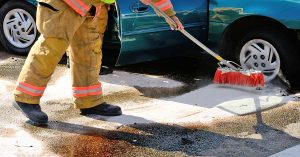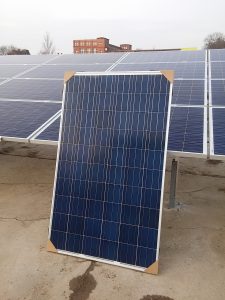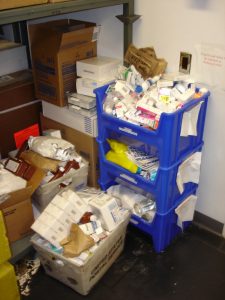
Oil-soaked absorbent material is a common waste stream in nearly all industrial settings, and proper disposal depends on several factors, including whether it constitutes a hazardous waste, whether it will be recycled or discarded, and in which state you’re located.
Follow these general federal guidelines to dispose of oil absorbents:
1. Prior to disposal of any waste stream, you must determine if it constitutes a hazardous waste. Used absorbents may be a hazardous waste based on the absorbed liquid or other contaminants. Any absorbents that may be contaminated with a hazardous waste MUST be characterized by the generator prior to disposal. Details on the waste characterization process are outlined by EPA. Once you are certain the absorbents only contain used oil, you must then determine if they contain free liquid.
2. If the absorbent contains free liquid oil, it must be handled following the used oil management standards. Free liquids cannot be disposed to a solid waste landfill, unless specifically exempted. To determine whether the free liquids are present, the “paint filter” test (USEPA test method 9095B) is used. This test involves placing 100 ml of the absorbent in a conical paint filter (fine mesh #60 +/- 5%) for 5 minutes. Absorbent materials may need to be cut up or crumbled to fit well in the filter. If any liquid seeps through the filter and drips, free liquids are deemed to be present. Do you need to perform this test for all oil absorbent you generate? No, but you do have to ensure waste sent to the landfill would not fail this test somehow. For absorbents, that often involves a degree of estimation. Absorbents that are dripping or that drip when squeezed by hand, likely will fail the paint filter test.
3. If you intend to reuse the absorbent, you can simply store it for future use or remove oil from the absorbent (for example, wringing or squeezing) before storage. Reusing absorbents when possible is both a cost-saving and pollution prevention measure.
Generally, materials containing or otherwise contaminated with used oil are regulated as used oil. Many states have promulgated regulations for disposing oil absorbents, so you must check your state’s regulations when determining a management strategy for your oil absorbents. In every state, you must first complete a hazardous waste determination on used absorbents; hazardous waste-contaminated absorbents must be handled as hazardous waste.
Following are examples of selected state requirements for non-hazardous used oil absorbents:
Arizona: Landfills will typically not accept used absorbent. Oil-soaked absorbents are managed in the same manner as used oil. Both on-spec and off-spec used oil must be recycled. If not recycled, it is considered hazardous waste. While in storage, you must follow the federal used oil regulations.
California: Oil-soaked absorbents are managed in the same manner as used oil. Used oil is a state-designated hazardous waste, meaning it has a state-only waste code for manifests. Businesses generating used oil are required to meet most of the hazardous waste generator requirements (Health and Safety Code section 25250.11). Containers of used oil must be labeled as both used oil and hazardous waste, as well as have the initial date of accumulation.
New York: Oily absorbents should be treated as hazardous waste unless they are recycled. Store absorbents in separate metal containers with lids, according to the New York State Department of Environmental Conservation Pollution Prevention Unit. Label them “Oily Waste Absorbents Only.”
Pennsylvania: Store oily absorbent in a leak-proof container, ensuring no free-standing liquid is present, and dispose of it as a municipal waste. Absorbents that have any sign of free-flowing oil are managed as used oil. If the absorbent is a rag, recycle it through an approved laundry or vendor service.
Texas: Absorbents that have any sign of free-flowing oil are managed as used oil, according to the Texas Commission on Environmental Quality (TCEQ). When there is no free-flowing oil on absorbents, they aren’t regulated as used oil unless they are burned for energy recovery.
Wisconsin: Oil absorbents can be disposed of in a landfill when waste oil has been drained, so there are no visible signs of free-flowing oil remaining on the absorbent materials, and the oil absorbent materials are non-hazardous waste as defined in 289.01(12), Wis. Stats, according to the Department of Natural Resources (DNR). The DNR’s preferred method for handling absorbents is through recycling or reuse.
Establishing a compliant oil absorbent management strategy will provide clarity for this very common waste stream. Please be sure to check your state regulations and consider contacting your landfill to discuss any special restrictions or procedures.
References:
- “Managing Used Oil: Answers to Frequent Questions for Businesses,” USEPA, November 2020, https://www.epa.gov/hw/managing-used-oil-answers-frequent-questions-businesses
- “The Ultimate Guide: How to Dispose of Used Rags and Oil Absorbents,” ITU AbsorbTech Blog, November 2020, https://ituabsorbtech.com/how-to-manage-used-rags-and-absorbents-a-federal-and-state-guide
- “Paint Filter Test Method EPA 9095b,” USEPA, December 2015, https://www.epa.gov/hw-sw846/sw-846-test-method-9095b-paint-filter-liquids-test
This post is for information and educational purposes only and does not constitute legal advice. Aarcher, Inc. makes no warranties, expressed or implied, concerning the accuracy, completeness, reliability, or suitability of the date, information, and guidance contained herein, and assumes no liability associated with the use of such data. Any use of this information by a party shall be at their sole risk.
 The Department of Toxic Substances Control (DTSC) held a public informational seminar on March 25, 2019 to present draft regulations that would revise California’s Universal Waste Program to include waste photovoltaic modules (PV modules), commonly known as solar panels. The informational session offered the opportunity for public discussion prior to the beginning of the formal rulemaking process.
The Department of Toxic Substances Control (DTSC) held a public informational seminar on March 25, 2019 to present draft regulations that would revise California’s Universal Waste Program to include waste photovoltaic modules (PV modules), commonly known as solar panels. The informational session offered the opportunity for public discussion prior to the beginning of the formal rulemaking process. Julia Norris is a California-based Certified Hazardous Material Manager, Certified Professional Environmental Auditor, and senior environmental protection specialist with 19 years of professional experience. She has expertise in a wide range of technical areas, including regulatory compliance auditing, air emissions inventories, SPCC Plans, drinking water sampling plans, SWPPPs, wastewater pretreatment programs, solid waste characterization studies, pollution prevention planning, hazardous material/waste management, storage tank management, and NEPA analysis.
Julia Norris is a California-based Certified Hazardous Material Manager, Certified Professional Environmental Auditor, and senior environmental protection specialist with 19 years of professional experience. She has expertise in a wide range of technical areas, including regulatory compliance auditing, air emissions inventories, SPCC Plans, drinking water sampling plans, SWPPPs, wastewater pretreatment programs, solid waste characterization studies, pollution prevention planning, hazardous material/waste management, storage tank management, and NEPA analysis. Once upon a time, EPA attempted to make pharmaceutical waste a universal waste. This proposal and draft rule (which attempted to make management of pharmaceutical waste less onerous for healthcare facilities) died on the vine and will likely never be finalized by EPA. Just in time for the holidays, however, EPA changed its strategy and published the final “Management Standards for Hazardous Waste Pharmaceuticals and Amendment to the P075 Listing for Nicotine” on December 11, 2018. According to the EPA press release, “This final rule establishes cost-saving, streamlined standards for handling hazardous waste pharmaceuticals to better fit the operations of the healthcare sector while maintaining protection of human health and the environment.”
Once upon a time, EPA attempted to make pharmaceutical waste a universal waste. This proposal and draft rule (which attempted to make management of pharmaceutical waste less onerous for healthcare facilities) died on the vine and will likely never be finalized by EPA. Just in time for the holidays, however, EPA changed its strategy and published the final “Management Standards for Hazardous Waste Pharmaceuticals and Amendment to the P075 Listing for Nicotine” on December 11, 2018. According to the EPA press release, “This final rule establishes cost-saving, streamlined standards for handling hazardous waste pharmaceuticals to better fit the operations of the healthcare sector while maintaining protection of human health and the environment.” The US Environmental Protection Agency’s (EPA) hazardous waste manifest system is designed to track hazardous waste from the time it leaves the generator facility where it was produced, until it reaches the off-site waste management facility that will store, treat or dispose of the hazardous waste. In 2014, the EPA established a national system for tracking hazardous waste shipments electronically. This system, known as “e-Manifest,” is intended to modernize the nation’s cradle-to-grave hazardous waste tracking process while saving valuable time, resources, and dollars for industry and states. EPA launched e-Manifest on June 30, 2018, along with user fees to offset the cost of the EPA developing the electronic manifest.
The US Environmental Protection Agency’s (EPA) hazardous waste manifest system is designed to track hazardous waste from the time it leaves the generator facility where it was produced, until it reaches the off-site waste management facility that will store, treat or dispose of the hazardous waste. In 2014, the EPA established a national system for tracking hazardous waste shipments electronically. This system, known as “e-Manifest,” is intended to modernize the nation’s cradle-to-grave hazardous waste tracking process while saving valuable time, resources, and dollars for industry and states. EPA launched e-Manifest on June 30, 2018, along with user fees to offset the cost of the EPA developing the electronic manifest. Robert A. (Bob) LaRosa, P.E. is an experienced environmental professional with over 30 years’ experience in the EH&S field in various field level, supervisory, and management positions. As a consulting engineer he has worked with clients in the manufacturing, chemical, petroleum, transportation, telecommunication, food and pharmaceutical industries to improve their environmental, health and safety programs and performance. He is a registered professional engineer in several states and serves as both an AARCHER consultant and instructor for the Aarcher Institute of Environmental Training. He can be reached at
Robert A. (Bob) LaRosa, P.E. is an experienced environmental professional with over 30 years’ experience in the EH&S field in various field level, supervisory, and management positions. As a consulting engineer he has worked with clients in the manufacturing, chemical, petroleum, transportation, telecommunication, food and pharmaceutical industries to improve their environmental, health and safety programs and performance. He is a registered professional engineer in several states and serves as both an AARCHER consultant and instructor for the Aarcher Institute of Environmental Training. He can be reached at